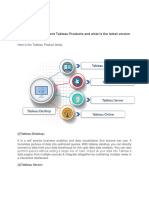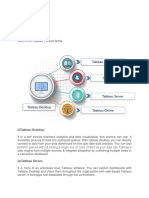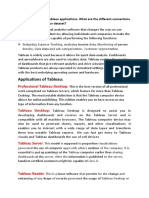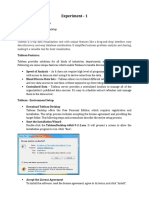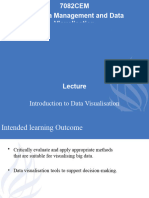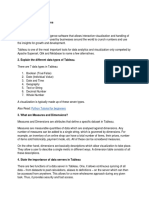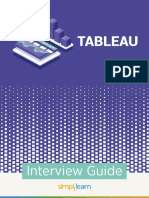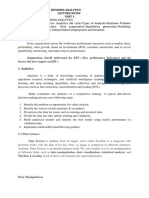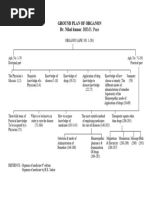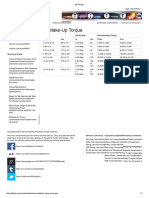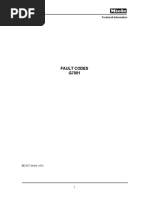Day 5 Tableau Interview QnA
Day 5 Tableau Interview QnA
Uploaded by
spandushetty28Copyright:
Available Formats
Day 5 Tableau Interview QnA
Day 5 Tableau Interview QnA
Uploaded by
spandushetty28Copyright
Available Formats
Share this document
Did you find this document useful?
Is this content inappropriate?
Copyright:
Available Formats
Day 5 Tableau Interview QnA
Day 5 Tableau Interview QnA
Uploaded by
spandushetty28Copyright:
Available Formats
### Basic Questions
What is Tableau
- Tableau is a data visualization tool that helps in simplifying raw data into an easily
understandable format. It provides interactive dashboards and visual analytics.
What are the different Tableau products
- Tableau Desktop, Tableau Server, Tableau Online, Tableau Public, and Tableau Prep.
What is a Tableau dashboard
- A dashboard is a collection of several visualizations, allowing users to analyze multiple data
views in one place.
What is the difference between Tableau Desktop and Tableau Server
- Tableau Desktop is used for creating visualizations, while Tableau Server is used to share
and collaborate on these visualizations over the web.
What are the types of filters in Tableau
- Context filters, Dimension filters, Measure filters, Relative date filters, and Top N filters.
### Intermediate Questions
What is a calculated field
- A calculated field is a new field that you create by using existing fields in your data set to
perform calculations.
Explain the difference between a join and a blend in Tableau
- A join combines data from multiple tables within the same data source, while a blend
combines data from different sources.
What are parameters in Tableau
- Parameters are dynamic values that can replace a constant value in calculations, filters, or
reference lines.
How can you improve performance in Tableau
- Optimize data extracts, minimize the use of complex calculations, use context filters, and
avoid excessive detail in visualizations.
What is the difference between a dimension and a measure
- Dimensions are qualitative fields that describe data (e.g., categories), while measures are
quantitative fields that can be aggregated (e.g., sales amounts).
### Advanced Questions
What is a data extract
- A data extract is a snapshot of data optimized for faster query performance, stored in a
compressed format.
How can you create a calculated field in Tableau
- Right-click on a data pane, select "Create Calculated Field," and enter your calculation
using Tableau's formula syntax.
What is a dual-axis chart
- A dual-axis chart allows you to display two different measures on the same axis, providing a
comparative view.
What is a trend line
- A trend line is a line added to a chart that indicates the general direction of data points over
time.
What are the different types of joins in Tableau
- Inner join, left join, right join, and full outer join.
### Data Handling
How do you connect to a data source in Tableau
- Open Tableau, select "Connect to Data," and choose your data source type (e.g., Excel,
SQL Server).
What is Tableau Prep
- Tableau Prep is a tool for data preparation, allowing users to clean and shape data before
analysis in Tableau.
What is a live connection vs. an extract in Tableau
- A live connection pulls data directly from the source in real-time, while an extract is a static
snapshot of data.
How do you handle null values in Tableau
- You can filter them out, replace them with default values, or use calculated fields to handle
them.
What are LOD expressions
- Level of Detail (LOD) expressions allow you to compute values at different granularity levels
without changing the view.
### Visualization Techniques
What are the different types of visualizations available in Tableau
- Bar charts, line charts, pie charts, scatter plots, maps, and more.
How can you create a heat map in Tableau
- Use a matrix of dimensions, and then assign color based on a measure to create a heat
map.
What is the purpose of a reference line
- A reference line is used to indicate a specific value or benchmark in a visualization for better
context.
How do you implement drill-down in Tableau
- By setting up hierarchies in dimensions, users can click to reveal more detailed data.
What are story points in Tableau
- Story points are a sequence of visualizations that work together to convey a narrative or
insight.
### Security and Sharing
How do you publish a workbook to Tableau Server
- From Tableau Desktop, select "Server" > "Publish Workbook" and follow the prompts to
configure sharing settings.
What is row-level security in Tableau
- Row-level security restricts data access for specific users, ensuring they only see relevant
data.
How can you schedule data refreshes in Tableau
- Use Tableau Server or Tableau Online to set up scheduled tasks for data extracts.
What is the purpose of Tableau’s permission model
- It controls user access to workbooks, data sources, and specific functionalities based on
roles.
What is Tableau Public
- Tableau Public is a free version of Tableau that allows users to publish visualizations to the
web.
### Troubleshooting
How do you troubleshoot performance issues in Tableau
- Check for excessive complexity in calculations, review data source connections, and
optimize extracts.
What should you do if your Tableau visualization is not updating
- Check the data connection, ensure the extract is refreshed, and verify filters and
parameters.
What is the “Performance Recorder” in Tableau
- A tool to analyze the performance of a workbook and identify bottlenecks.
How do you resolve issues with missing data in Tableau
- Verify data source connections, check for filters, and ensure that data has been loaded
properly.
What common errors might you encounter in Tableau
- Data type mismatches, aggregation errors, and connection issues.
### General Concepts
What is data blending
- Data blending combines data from different sources in Tableau to create a unified view.
Explain the concept of data normalization
- Data normalization is the process of organizing data to reduce redundancy and improve
data integrity.
What is a visualization best practice
- Use clear titles, maintain a logical layout, choose appropriate chart types, and minimize
clutter.
How do you export a Tableau visualization
- Use the “Export” option to save as an image, PDF, or Tableau Packaged Workbook.
What is the significance of context filters
- Context filters define a subset of data that other filters act upon, improving performance.
### Real-world Scenarios
Describe a challenging project you worked on in Tableau
- (Your answer should highlight a specific challenge, your approach, and the outcome.)
How do you ensure data quality in Tableau
- Implement checks during data preparation, verify data sources, and conduct regular audits.
Give an example of how you’ve used Tableau to drive business decisions
- (Share a specific instance where your analysis influenced a decision.)
How would you approach a project with limited data
- Focus on available data, identify key metrics, and utilize data blending if needed.
What steps do you take when starting a new Tableau project
- Define objectives, gather requirements, assess data sources, and sketch initial
visualizations.
### Best Practices
What are some best practices for dashboard design
- Keep it simple, ensure alignment, use consistent colors, and provide clear navigation.
How do you handle large datasets in Tableau
- Use extracts, summarize data, and filter unnecessary details for better performance.
What is the importance of color in Tableau visualizations
- Color can highlight key data points, create emphasis, and improve readability.
How can you ensure accessibility in your Tableau dashboards
- Use sufficient color contrast, provide alternative text for visuals, and consider screen reader
compatibility.
What is the importance of user feedback in dashboard design
- User feedback helps refine the dashboard to better meet the needs and expectations of the
audience.
### Tableau Features
What is Tableau's “Show Me” feature
- A tool that suggests different visualization types based on the data fields selected.
How do you create a histogram in Tableau
- Use the "Create Calculated Field" option to define bins and then plot them as a bar chart.
What are sets in Tableau
- Sets are custom fields that define a subset of data based on specific conditions.
What is a scatter plot
- A scatter plot shows the relationship between two quantitative measures, often used to
identify trends or correlations.
How can you integrate R or Python with Tableau
- Use calculated fields to call R or Python scripts for advanced analytics and modeling.
### Data Analysis
What is a KPI and how can you implement it in Tableau
- A Key Performance Indicator measures the success of an organization; you can create a
calculated field to represent it visually.
How do you calculate Year-over-Year growth in Tableau
- Use calculated fields to compare current year data against previous year data.
What is the use of clustering in Tableau
- Clustering groups similar data points together based on defined measures, helping identify
patterns.
How can you perform a cohort analysis in Tableau
- Create calculated fields to segment data based on shared characteristics or time periods.
What is the significance of date calculations in Tableau
- Date calculations allow for analysis over time, helping to identify trends and seasonality.
### Additional Technical Questions
What is a Tableau Data Source Filter
- A data source filter limits the data available to the entire data source before any
visualizations are created.
How do you use Tableau’s built-in analytics features
- Utilize features like trend lines, reference lines, and forecasting tools to enhance analysis.
What are “bins” in Tableau
- Bins group continuous values into discrete ranges, useful for histograms.
How do you create a calculated field for percentage of total
- Use a formula like `[Measure] / SUM([Measure])` to compute the percentage of a total.
What is the significance of “Keep Only” and “Exclude” options in Tableau
- “Keep Only” filters the view to show only the selected data, while “Exclude” removes it from
the view.
### Advanced Analytics
Explain the purpose of forecasting in Tableau
- Forecasting predicts future values based on historical data trends.
How do you implement data-driven alerts in Tableau
- Set up alerts based on specific thresholds in Tableau Server or Tableau Online to notify
users of changes.
What are “Table Calculations” in Tableau
- Table calculations are computations performed on the data in the view, such as running
totals or moving averages.
How do you calculate moving averages in Tableau
- Use the "Moving Average" table calculation option on a measure.
What is a custom SQL query in Tableau
- A custom SQL query allows you to write SQL code to retrieve and manipulate data before
importing it into Tableau.
### Practical Skills
How would you handle time zone differences in Tableau
- Use calculated fields to adjust time data to the relevant time zone.
What are dashboard actions in Tableau
- Dashboard actions allow users to interact with visualizations, such as filtering or highlighting
related data.
How do you create a bullet chart in Tableau
- Use a combination of bar charts and reference lines to create a bullet chart.
What is the use of the "Format" pane in Tableau
- The Format pane allows users to customize the appearance of charts, including colors,
fonts, and lines.
How do you create a data hierarchy in Tableau
- Drag dimensions into the same folder in the data pane to create a hierarchy.
### Communication and Collaboration
How do you explain your visualizations to non-technical stakeholders
- Focus on the insights and implications rather than technical details, using clear language
and visuals.
What role does storytelling play in Tableau dashboards
- Storytelling helps convey insights more effectively, guiding users through the data narrative.
How do you gather requirements for a Tableau project
- Conduct interviews with stakeholders, review existing reports, and clarify objectives.
How do you manage project timelines in Tableau
- Use project management tools to track progress, set deadlines, and communicate with
stakeholders.
What are some common mistakes people make with Tableau
- Overcomplicating dashboards, using too many colors, and neglecting user needs are
common pitfalls.
### Final Thoughts
What new features have been added in the latest Tableau release
- (Discuss any recent updates or features relevant to your version of Tableau.)
What resources do you use to stay updated on Tableau
- Tableau’s official website, community forums, blogs, and training courses.
How do you ensure your Tableau skills remain relevant
- Regular practice, attending webinars, and completing advanced training courses.
What advice would you give to someone new to Tableau
- Start with basic visualizations, explore sample data sets, and take advantage of online
resources.
How can you measure the success of a Tableau project
- Evaluate user engagement, feedback, and the impact on decision-making.
### Scenario-Based Questions
How would you handle a situation where stakeholders have conflicting requirements
- Facilitate discussions to understand priorities and find a middle ground based on business
objectives.
What would you do if you identified a data quality issue in a Tableau dashboard
- Investigate the source of the issue, communicate with relevant teams, and propose
solutions to correct it.
Describe a time when you had to present complex data to an audience
- (Share your experience, emphasizing your approach to simplifying the data and engaging
the audience.)
How would you approach a dashboard redesign based on user feedback
- Analyze feedback, identify key improvement areas, and prioritize changes that enhance
usability and insights.
What techniques do you use to maintain user engagement with your dashboards
- Regular updates, interactive elements, and incorporating user feedback into designs.
### Future Trends
What do you see as the future of data visualization tools like Tableau
- Increased integration with AI and machine learning, enhanced interactivity, and focus on
data storytelling.
How will advancements in data analytics impact the use of Tableau
- Enhanced predictive analytics and automation will allow users to derive insights more
efficiently.
What role do you think Tableau will play in the era of big data
- Tableau will become essential for simplifying complex datasets and enabling real-time
analytics.
How do you envision the evolution of dashboard design
- More emphasis on user experience, personalization, and mobile-friendly designs.
What emerging technologies do you think will influence Tableau's development
- AI, machine learning, and advanced data processing technologies.
### Personal Insights
What do you enjoy most about working with Tableau
- (Share your personal motivations and interests related to data visualization.)
How do you balance creativity and technical skills in Tableau
- Embrace both aspects, using technical skills to enable creative visualizations that tell
compelling stories.
What is your favorite Tableau project you’ve worked on
- (Discuss a specific project that was particularly impactful or rewarding.)
How do you handle tight deadlines while working with Tableau
- Prioritize tasks, communicate effectively, and focus on essential deliverables.
What is your long-term vision for your career with Tableau
- (Discuss your aspirations, whether it's advancing in analytics, becoming a Tableau expert,
or leading projects.)
You might also like
- Download Complete Hypertension: A Companion to Braunwald's Heart Disease 3rd Edition George L. Bakris - eBook PDF PDF for All ChaptersDocument41 pagesDownload Complete Hypertension: A Companion to Braunwald's Heart Disease 3rd Edition George L. Bakris - eBook PDF PDF for All Chaptersgernangeten100% (2)
- BOLMAN - AND - DEAL Test Bank by Barbara McKeonDocument84 pagesBOLMAN - AND - DEAL Test Bank by Barbara McKeonitwasawesome100% (2)
- Public Health Nursing and The Disaster Management CycleDocument25 pagesPublic Health Nursing and The Disaster Management CycleLeadisti ArianiNo ratings yet
- 100 Tableau Interview QuestionsDocument27 pages100 Tableau Interview QuestionsChristine Cao100% (3)
- DWH FAQS To YourDocument16 pagesDWH FAQS To YourKranti KumarNo ratings yet
- TABLEAUDocument3 pagesTABLEAUShweta SainiNo ratings yet
- Tablue Et GoDocument16 pagesTablue Et GoKranti KumarNo ratings yet
- Tableau IntroductionDocument15 pagesTableau Introductionkaranjeet singhNo ratings yet
- Filters in TableauDocument3 pagesFilters in Tableausnippet oneNo ratings yet
- Tableau Descriptive QuestionsDocument24 pagesTableau Descriptive Questionsrehaank816No ratings yet
- InterviewBit Tableau Interview QuestionsDocument24 pagesInterviewBit Tableau Interview QuestionsCarlos PereaNo ratings yet
- ADV (1)Document32 pagesADV (1)pgdrivestorage3No ratings yet
- Top Tableau Questionsand Answersin 2019Document20 pagesTop Tableau Questionsand Answersin 2019Vaishnavi AppayaNo ratings yet
- Business Intelligence and Visualization: END Semester Assignment Course Code - BC10077Document16 pagesBusiness Intelligence and Visualization: END Semester Assignment Course Code - BC10077Abhishek BidhanNo ratings yet
- Data Gyan Tableau Interview Q&ADocument21 pagesData Gyan Tableau Interview Q&APrince Thomas TharakunnelNo ratings yet
- Tableau Interview QuestionsDocument16 pagesTableau Interview QuestionsKranti KumarNo ratings yet
- PS Case Study PDFDocument7 pagesPS Case Study PDFanushkaanilsinghNo ratings yet
- Top Tableau Questions and Answers in 2019: June 2019Document20 pagesTop Tableau Questions and Answers in 2019: June 2019Devi Vara Prasad100% (1)
- Tableau QuestionsDocument3 pagesTableau QuestionsMy online ShoppingNo ratings yet
- TableauDocument110 pagesTableauMahesh kumar100% (2)
- Tableau Ans.Document25 pagesTableau Ans.shubham chatterjeeNo ratings yet
- Abhishek TableauDocument11 pagesAbhishek TableauAbhishek BidhanNo ratings yet
- Whitepaper Advanced Analytics With Tableau EngDocument21 pagesWhitepaper Advanced Analytics With Tableau EngAshhar AshrafiNo ratings yet
- DVC - All Questions and Answers - CT 1, CT 2 and Model - FinalDocument114 pagesDVC - All Questions and Answers - CT 1, CT 2 and Model - Finalstephyjames80No ratings yet
- Shopee Fundamental Data Analytical ThinkingDocument33 pagesShopee Fundamental Data Analytical ThinkingDaiana HandiNo ratings yet
- Tableau_and_PowerBI_ConceptsDocument4 pagesTableau_and_PowerBI_Conceptspavan dhodmaneNo ratings yet
- Tableau Interview QuestionsDocument58 pagesTableau Interview QuestionsNaman SharmaNo ratings yet
- Tableau TutorialDocument5 pagesTableau TutorialWaqas RafiqueNo ratings yet
- Wepik Unlocking Insights With Tableau Harnessing The Power of Data Analytics 20231121180407vt6ZDocument11 pagesWepik Unlocking Insights With Tableau Harnessing The Power of Data Analytics 20231121180407vt6Zfiles.skiruthikNo ratings yet
- Tableau Interview QuestionsDocument19 pagesTableau Interview QuestionsRaviindra singhNo ratings yet
- Content Beyond BaDocument8 pagesContent Beyond BasureshmadhuwinNo ratings yet
- Business PracticalsDocument54 pagesBusiness PracticalspameluftNo ratings yet
- UiPath Interview QuestionsDocument9 pagesUiPath Interview QuestionsBalaji hope tutorsNo ratings yet
- DV Lab ManualDocument73 pagesDV Lab ManualThrisha K B BabuNo ratings yet
- Data Visulization and Power Bi Lab ManualDocument42 pagesData Visulization and Power Bi Lab Manualgugulothubhavith2005No ratings yet
- Tableau- HR DATA SET QUESTIONSDocument2 pagesTableau- HR DATA SET QUESTIONS18.srinidhiNo ratings yet
- 7082CEM - 1920 - Data Vis - Lecture - 1692517742913Document34 pages7082CEM - 1920 - Data Vis - Lecture - 1692517742913Manish049No ratings yet
- Portfolio File No. v7bDocument6 pagesPortfolio File No. v7bUsama Riaz VlogsNo ratings yet
- IJCSP23D1138Document7 pagesIJCSP23D1138abhi_?1988No ratings yet
- 1726043999428_manual of Power BiDocument69 pages1726043999428_manual of Power Bikalpanamrec23No ratings yet
- Tableau Tutorial - Learn Data Visualization Using TableauDocument19 pagesTableau Tutorial - Learn Data Visualization Using TableauDevi Vara Prasad100% (1)
- Answers. The Questions Presented in This Blog Are Collected Based On The Opinion ofDocument39 pagesAnswers. The Questions Presented in This Blog Are Collected Based On The Opinion ofSuchitraNo ratings yet
- Tableau Interview Questions 1Document22 pagesTableau Interview Questions 1Christine CaoNo ratings yet
- Teradata Warehouse MinerDocument3 pagesTeradata Warehouse MinerKakarla SatyanarayanaNo ratings yet
- Introduction To TableauDocument39 pagesIntroduction To TableauAdil Bin KhalidNo ratings yet
- 8 Tableau bq2 7836659Document38 pages8 Tableau bq2 7836659Sudharshan VenkateshNo ratings yet
- Business Anaytics Unit 1Document37 pagesBusiness Anaytics Unit 1K.V.T SNo ratings yet
- Tableau Training Manual 9.0 Basic Version: This Via Tableau Training Manual Was Created for Both New and IntermediateFrom EverandTableau Training Manual 9.0 Basic Version: This Via Tableau Training Manual Was Created for Both New and IntermediateRating: 3 out of 5 stars3/5 (1)
- Tableau: Interview GuideDocument24 pagesTableau: Interview GuidePandian NadaarNo ratings yet
- SDC Lab Manual (Mid - 1)Document35 pagesSDC Lab Manual (Mid - 1)nopapo7909No ratings yet
- Tab 4Document4 pagesTab 4ribilay106No ratings yet
- Kenny-230718-Top 70 Microsoft Data Science Interview QuestionsDocument17 pagesKenny-230718-Top 70 Microsoft Data Science Interview QuestionsvanjchaoNo ratings yet
- Tableau QuestionsDocument11 pagesTableau Questionskaranjeet singhNo ratings yet
- Unit 1 NotesDocument39 pagesUnit 1 Noteszaaya3103No ratings yet
- Vijay Rathod TableauDocument3 pagesVijay Rathod TableauVijay rathodNo ratings yet
- Tableau by Yash RajputDocument58 pagesTableau by Yash Rajputunknownfacts0405No ratings yet
- Tableau - Diabetes Dataset AssessmentDocument2 pagesTableau - Diabetes Dataset AssessmentHuzaifa QamashNo ratings yet
- Model Q&AOn TableauDocument4 pagesModel Q&AOn TableauUjjawalNo ratings yet
- Tableau PowerBi Interview QnAs by CloudyML 1679549516Document9 pagesTableau PowerBi Interview QnAs by CloudyML 1679549516danny7donkovNo ratings yet
- Tableau 2018.1Document127 pagesTableau 2018.1wildrumpus7100% (1)
- unit 2 dwmDocument16 pagesunit 2 dwmnishigandha thubrikarNo ratings yet
- Dta102 - Bid102 - Day 2Document21 pagesDta102 - Bid102 - Day 2Adedamola AdegokeNo ratings yet
- Hand Pumps - Tharparker Pakistan - 2018Document11 pagesHand Pumps - Tharparker Pakistan - 2018KARWAN DEVELOPMENT FOUNDATIONNo ratings yet
- Report GliderDocument29 pagesReport GliderAmirul Haqim Mohd JoraNo ratings yet
- Subversive Pleasures Bakhtin Cultural CRDocument24 pagesSubversive Pleasures Bakhtin Cultural CRazucena mecalcoNo ratings yet
- Egregore PDFDocument3 pagesEgregore PDFRoberto Lopes Jesus100% (2)
- Hyoki Lee, Zach Zens Dr. Kim Pierson PH.D., Dr. Peter Bui PH.DDocument1 pageHyoki Lee, Zach Zens Dr. Kim Pierson PH.D., Dr. Peter Bui PH.DFerryNo ratings yet
- Organon GroundplanDocument1 pageOrganon GroundplanMd Abdul JabbarNo ratings yet
- Craftsman 98023 40V 12V Lithium-Ion Cordless ChainsawDocument6 pagesCraftsman 98023 40V 12V Lithium-Ion Cordless ChainsawJoe ZhaoNo ratings yet
- BSBSTR601 Simulation Pack - Task 2 ResourcesDocument17 pagesBSBSTR601 Simulation Pack - Task 2 Resourcesmarkeen212No ratings yet
- System 350™ Pressure Application: Condenser Fan CyclingDocument2 pagesSystem 350™ Pressure Application: Condenser Fan CyclingcesarintiNo ratings yet
- ch7-ER DIAGRAMDocument57 pagesch7-ER DIAGRAMkhushi jhaNo ratings yet
- Bit TorquesDocument1 pageBit TorquesEloy RosilloNo ratings yet
- HighwayDocument4 pagesHighwayShaneene Berlyn AgulayNo ratings yet
- Nov 20th Materai Lice AgmDocument14 pagesNov 20th Materai Lice AgmgamerkoteshchannelNo ratings yet
- The Effect of Organizational Culture On Organization Performance in The Case of Commercial Bank of Ethiopia Southern Addis Ababa DistrictDocument119 pagesThe Effect of Organizational Culture On Organization Performance in The Case of Commercial Bank of Ethiopia Southern Addis Ababa DistrictFasil100% (2)
- Macedonian Studies Journal, Vol 1 Issue 2, 2014Document168 pagesMacedonian Studies Journal, Vol 1 Issue 2, 2014Makedonas Akritas100% (1)
- G7881 Fault CodDocument16 pagesG7881 Fault CodMai Doan Nhu ThuanNo ratings yet
- System Error Codes (500-999) (Windows)Document32 pagesSystem Error Codes (500-999) (Windows)Md. ROman MiahNo ratings yet
- CEE 110 Lecture 1Document29 pagesCEE 110 Lecture 1Tousif RahmanNo ratings yet
- Amte 235Document36 pagesAmte 235Allen Neill ValeraNo ratings yet
- Arrays: Instructor's Manual Table of ContentsDocument10 pagesArrays: Instructor's Manual Table of ContentsLeonard GojerNo ratings yet
- Software Requirements Specification: Automated Railway Reservation SystemDocument37 pagesSoftware Requirements Specification: Automated Railway Reservation SystemRahul KumarNo ratings yet
- Organometallics - Part 2Document33 pagesOrganometallics - Part 2Rohan Bhupen Shah ae22b052No ratings yet
- Culture and Its Related ConceptsDocument48 pagesCulture and Its Related ConceptsThu ThuỷNo ratings yet
- Micro Project Group No 08 WPCDocument10 pagesMicro Project Group No 08 WPCchaudharivishal1171No ratings yet
- Los Angeles: Luka Arapovic 3.eDocument19 pagesLos Angeles: Luka Arapovic 3.eLuka ArapovićNo ratings yet
- ONLINE LEC 3 UnconformitiesDocument19 pagesONLINE LEC 3 UnconformitiesAsfandyar KhanNo ratings yet
- JI 32 DFV Legal NeedsDocument40 pagesJI 32 DFV Legal NeedsToby VueNo ratings yet




